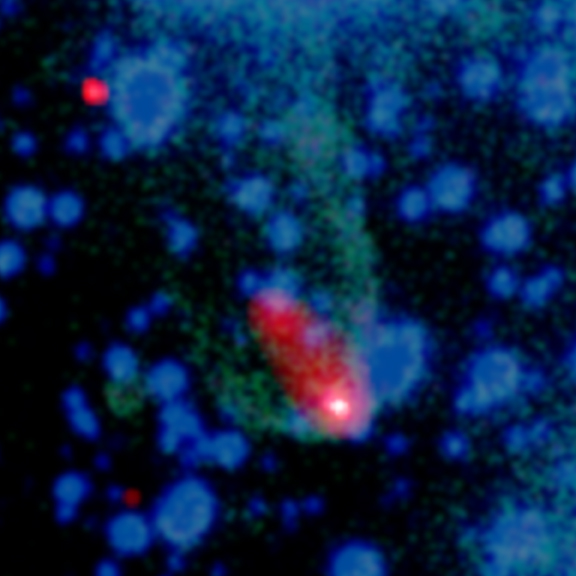
 Credit: X-ray: NASA/CXC/ASTRON/B.Stappers et al., Optical: AAO/J.Bland-Hawthorn & H.Jones
Credit: X-ray: NASA/CXC/ASTRON/B.Stappers et al., Optical: AAO/J.Bland-Hawthorn & H.Jones
Black Widow's Wake
The "black widow" pulsar is a rapidly spinning neutron star which is orbiting and rapidly wearing away a low mass companion star. It is thought that material stripped from the companion and accreted by the neutron star has spun up the neutron star. The Chandra X-ray observatory has now imaged this system and has shown in the finest detail ever how this weakly magnetized pulsar interacts with the material in its surroundings. The image above is a composite X-ray/optical image; the x-ray emission is shown in red-white while the optical emission is in blue & green. Chandra detected X-ray emission from the pulsar itself, along with emission from a "trailing wake" which extends behind the neutron star (which is moving through the galaxy at nearly one million kilometers per hour). The optical image also shows a faint bow shock in front of the X-ray wake. Chandra shows that this spun-up, "rejuvenated" milli-second pulsar (it spins one thousand times per second) produces matter and anti-matter streams efficiently like its younger, fast-spinning cousins.
Last Week *
HEA Dictionary * Archive
* Search HEAPOW
* Education
Each week the HEASARC
brings you new, exciting and beautiful images from X-ray and Gamma ray
astronomy. Check back each week and be sure to check out the HEAPOW archive!
Page Author: Dr. Michael F. Corcoran
Last modified March 2, 2003


